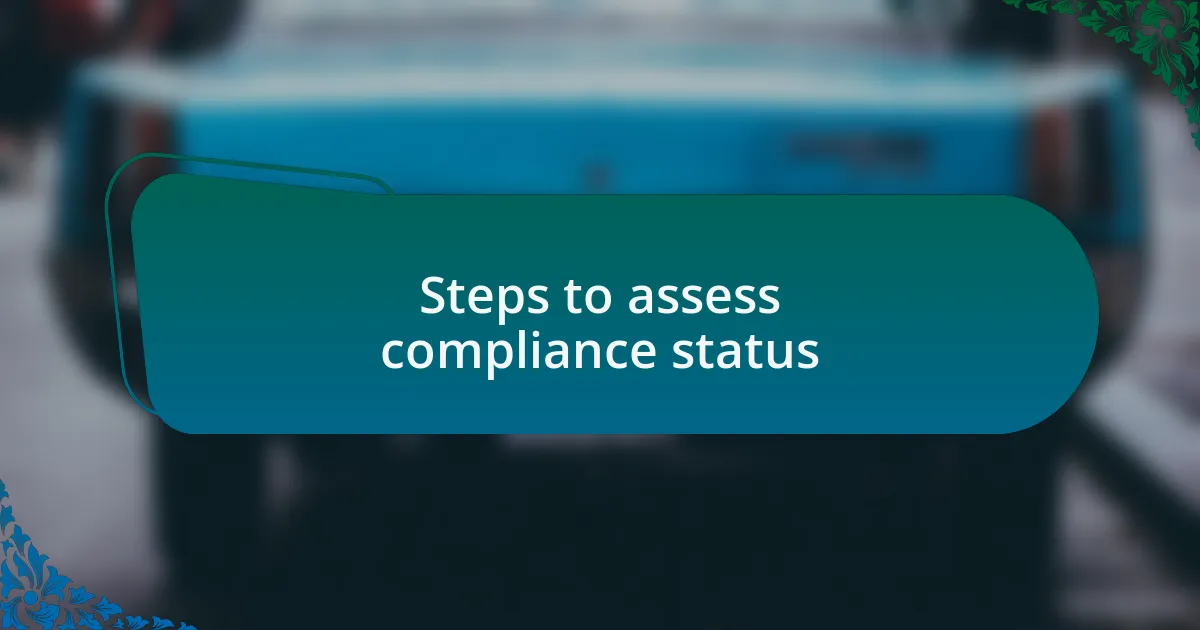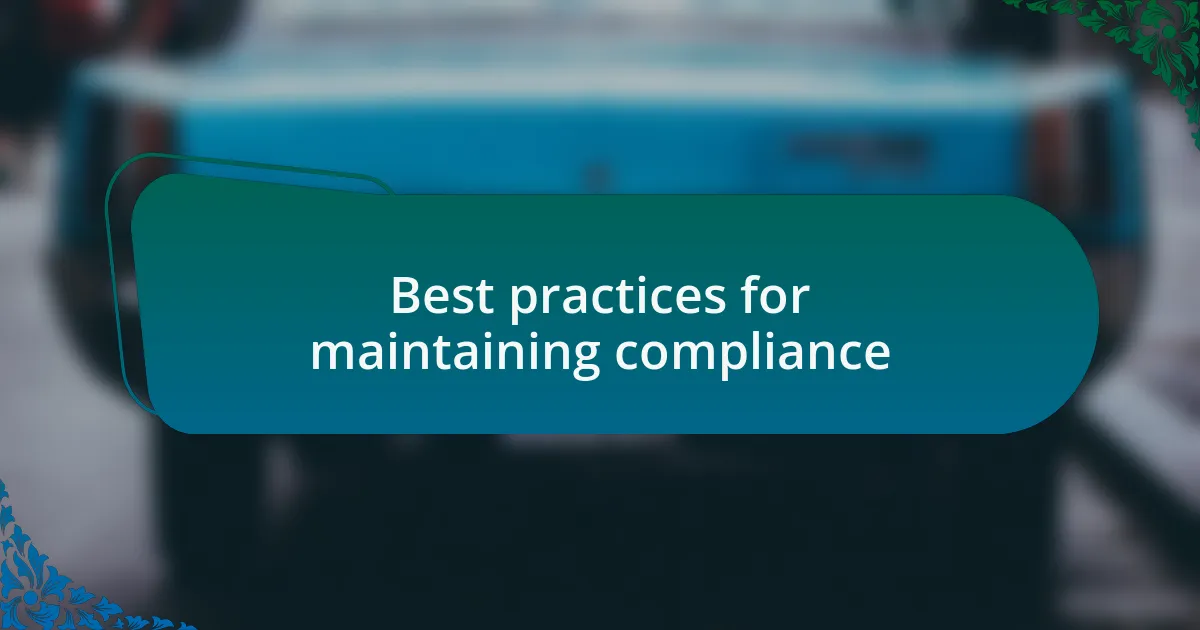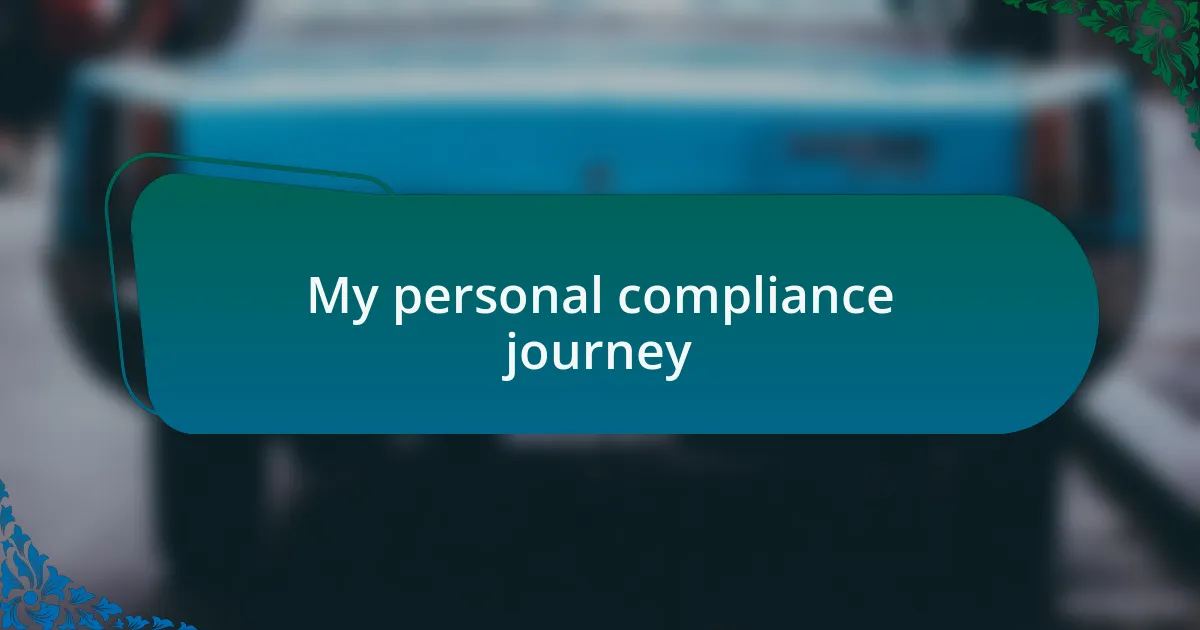Key takeaways:
- Staying proactive and informed about compliance regulations is crucial for environmental responsibility and operational ethics.
- Regular internal audits and open communication with staff can identify compliance gaps and foster a culture of accountability.
- Utilizing compliance tracking tools and management software streamlines staying updated on regulatory changes.
- Building a culture of training and adaptability helps organizations respond effectively to new regulations and strengthens team cohesion.

Understanding compliance with regulations
Understanding compliance with regulations is crucial in the car wash industry. From my experience, I’ve found that staying informed about local, state, and federal guidelines can feel overwhelming at times. You might wonder: how can one possibly keep track of all these rules? Well, it requires a proactive approach.
I recall a time when I overlooked a minor regulation about wastewater management. It wasn’t just a headache; it became a significant learning moment. Understanding compliance isn’t just about avoiding penalties; it fosters a sense of responsibility towards the environment and the community. It’s really about ensuring that we operate in a way that is ethical and transparent.
Moreover, I often think about the broader implications of compliance. What happens when regulations shift? When I faced this situation, I had to adapt quickly, which only reinforced my appreciation for the importance of staying updated. Engaging with industry associations and attending workshops has become essential for me. It’s about commitment and understanding the ‘why’ behind regulations—not just the ‘what.’

Steps to assess compliance status
To effectively assess compliance status, I start by conducting a thorough internal audit of our operations. This involves reviewing procedures and records against current regulations. I remember tackling this task one year and discovering several gaps in our documentation. It was a bit daunting, but addressing those gaps not only improved our compliance but also built our team’s confidence in our practices.
After performing the audit, I often engage in discussions with my staff about potential areas of risk. It’s important to foster a culture where everyone feels comfortable sharing their experiences. One instance sticks with me; a team member pointed out a regulation they thought we were not meeting. That prompted a deeper investigation and ultimately led to a change in our processes, highlighting how valuable communication can be.
Finally, I believe in the importance of staying connected with regulatory updates and changes. I make it a point to subscribe to relevant newsletters and attend webinars. Recently, a webinar I joined revealed new guidelines that could impact our water usage. Staying proactive not only helps avoid last-minute scrambles but also reinforces our commitment to compliance as a core value of our business.

Best practices for maintaining compliance
Maintaining compliance is a continual process that requires vigilance and adaptability. One effective practice I’ve found is creating a compliance checklist that aligns with both local and federal regulations. I remember instituting this checklist after realizing some requirements had slipped through our fingers during busy seasons. It transformed our daily operations and provided a tangible way to track our adherence.
Regular training sessions are also crucial for ensuring that everyone on the team understands their responsibilities related to compliance. I recall hosting a workshop where we role-played potential compliance scenarios. The excitement was palpable as my team engaged in discussions, brainstorming solutions together. This not only built their confidence but also deepened their understanding of the regulations governing our industry. How often do we stop to ensure our entire team is on the same page? It’s in these moments of learning that we truly fortify our practices.
Lastly, documenting processes and decisions cannot be overlooked. I’ve seen firsthand how meticulous record-keeping can save us during audits or inspections. A few months ago, we were able to swiftly resolve a query because we had detailed notes on previous compliance discussions. When unexpected questions arise, having that paperwork at our fingertips is invaluable. It turns what could be a stressful situation into an opportunity to showcase our diligence.
![]()
Tools for tracking regulatory changes
Utilizing regulatory tracking tools can significantly ease the burden of maintaining compliance. In my experience, subscribing to online regulatory databases proved invaluable. I remember the moment I received an alert about a new state environmental regulation that could have impacted our operations. Thanks to this tool, we had time to adjust before the changes took effect, preventing any potential compliance pitfalls.
Another resource I’ve found to be effective is compliance management software. A few months back, I decided to implement a tool that consolidated updates from various regulatory bodies into one dashboard. This transformation was a game-changer for us. Instead of sifting through emails and newsletters, everything was presented in a clear format. Have you ever felt overwhelmed by the sheer volume of information? This software helped filter the noise, allowing me to focus on what truly mattered for our compliance efforts.
Moreover, engaging with industry associations can also keep you informed. I recall attending a conference where updates on regulations were shared and discussed in depth. The insights from those sessions provided me not only with knowledge but also with connections to others facing the same challenges. It made me realize the power of community in navigating the complexities of compliance. How are you leveraging your network to stay updated?

My personal compliance journey
The journey to compliance is often fraught with unexpected challenges. I vividly recall the first time we faced an audit; I felt a mix of dread and determination. My team and I meticulously gathered documents, ensuring every detail was in place. That experience taught me that being proactive not only alleviates stress but also builds confidence in our operations.
As I ventured further down the compliance path, I discovered the importance of fostering a culture of accountability within our organization. I introduced regular training sessions to highlight the significance of regulatory adherence. Watching my colleagues engage and ask questions made me realize how empowering it can be to involve everyone in the process. Have you ever seen how a little education can transform skepticism into enthusiasm?
Reflecting on my compliance journey, I find that adaptability has been one of the most crucial traits I’ve developed. I remember a particular instance when a new regulation emerged seemingly out of nowhere, threatening to disrupt our workflow. Instead of panicking, I gathered my team to brainstorm potential solutions. That collaborative effort not only helped us comply but also strengthened our team’s bond. How do you foster adaptability in your own journey?